How to Make Perfect Basmati Rice (Like your Favorite Indian Restaurant)
Learn how to make perfect basmati rice just like your favorite Indian restaurant! This fluffy, fragrant rice is easy to achieve at home with my method.
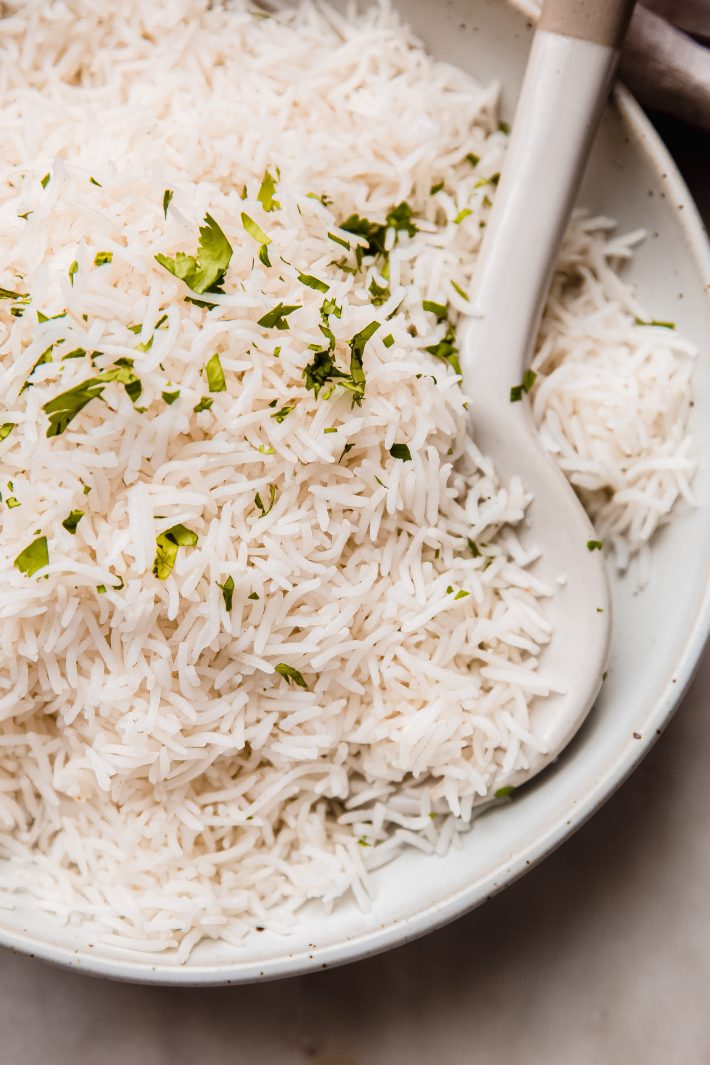
Warm, fluffy homemade basmati rice.
Growing up in a semi Indian household, it’s a smell that I still find comforting to this day. And if you’ve ever been to an Indian restaurant, you know what I’m talking about. The minute they set that dish of rice down, the steam rises from the bowl and wraps you in it in the coziest of ways.
The method for cooking basmati rice is a little different than other rice you may have cooked in the past. Usually, when you cook rice, you’re used to working with a ratio, be it 1:1 or 1:2, and so on. With basmati rice, there are two key techniques to keep in mind and I’ll explain them below.
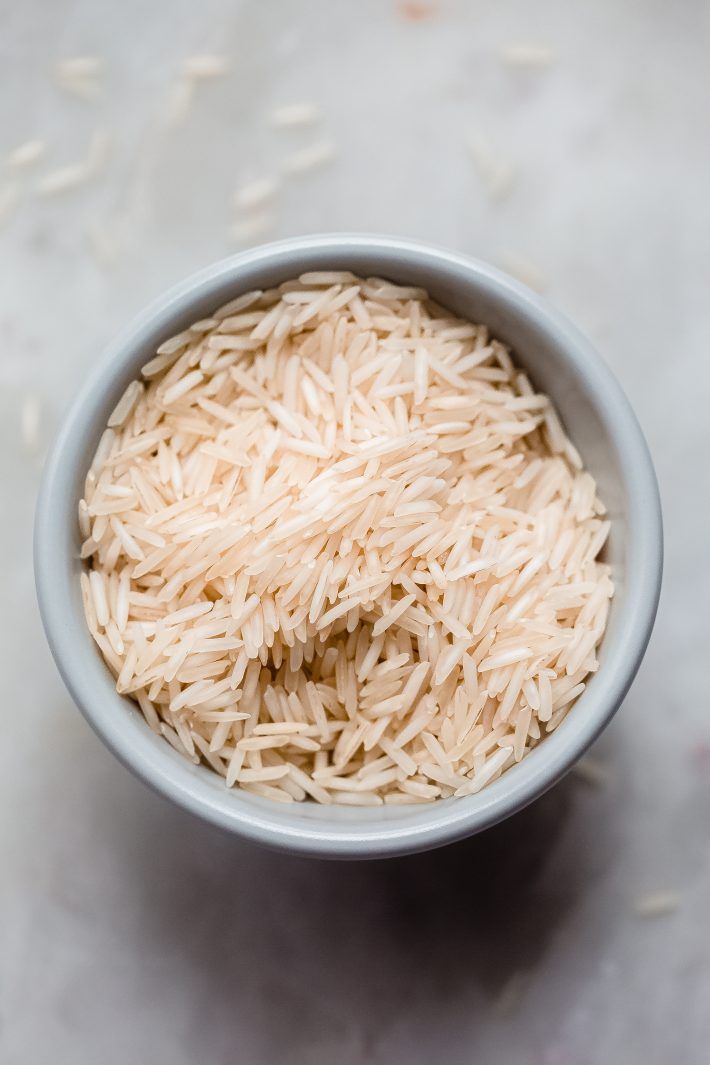
The key to making perfectly fluffy basmati rice is to soak it as you would beans and cook it like you would pasta.
Why do you soak basmati rice before cooking it?
Just like when you’re working with dried beans, soaking the rice ahead of time in room temperature water allows the rice to absorb some of the water. Since the rice has soaked in water, it decreases the amount of time you’d need to boil the rice.
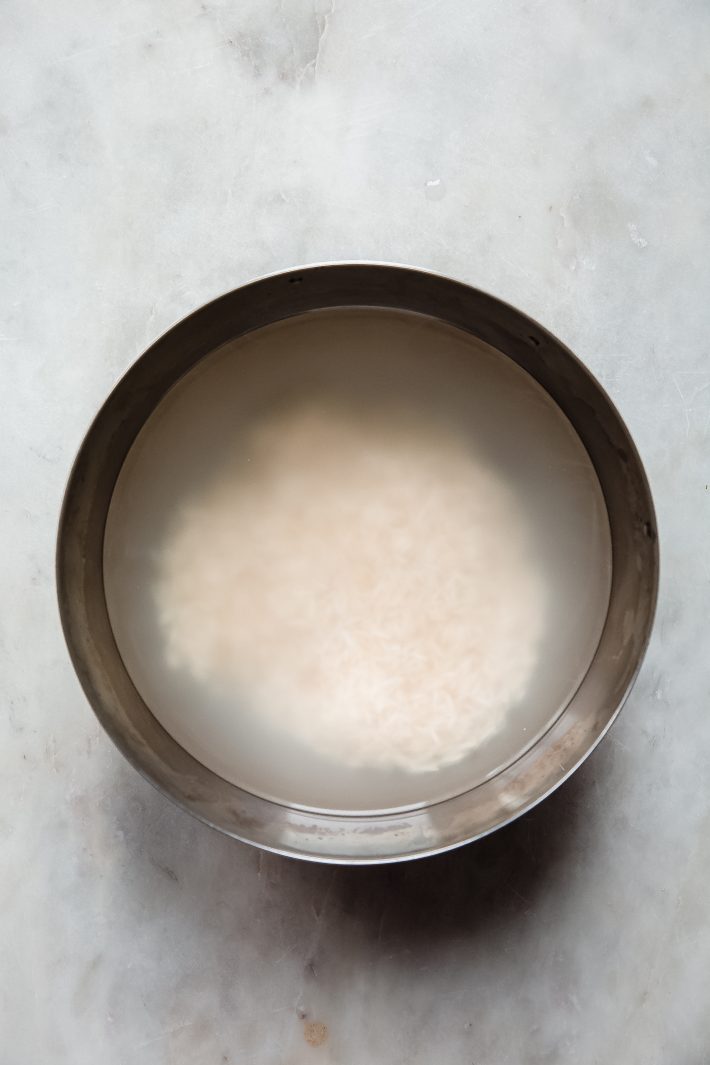
What do you need to make basmati rice?
- Basmati rice: You want to use a long grain basmati rice for this recipe. If you can get your hands on an Indian brand of rice, that would be best. A lot of mainstream grocery stores have actually started stocking the more popular brands. This is my favorite brand to use. It has been my go-to basmati rice for the last 8 years. It is almost double the cost online, so if you have an Indian store close by, show the grocery store clerk a picture of the packaging, and I’m pretty sure they have some for you to purchase!
- Water: Don’t be alarmed; my recipe uses a lot more water than most rice recipes. We’re going to cook the rice like you would pasta.
- Salt: I exclusively use kosher salt at home and suggest the quantity to use for that. If you use table salt, you’ll want to use less so that the rice isn’t too salty.
- White Vinegar: is cheap and easy to find, so that’s what is usually used.
- Oil: You can use any oil you like. We drizzle it in the pot before we steam the rice. Ghee or butter also work and would give the rice additional flavor.
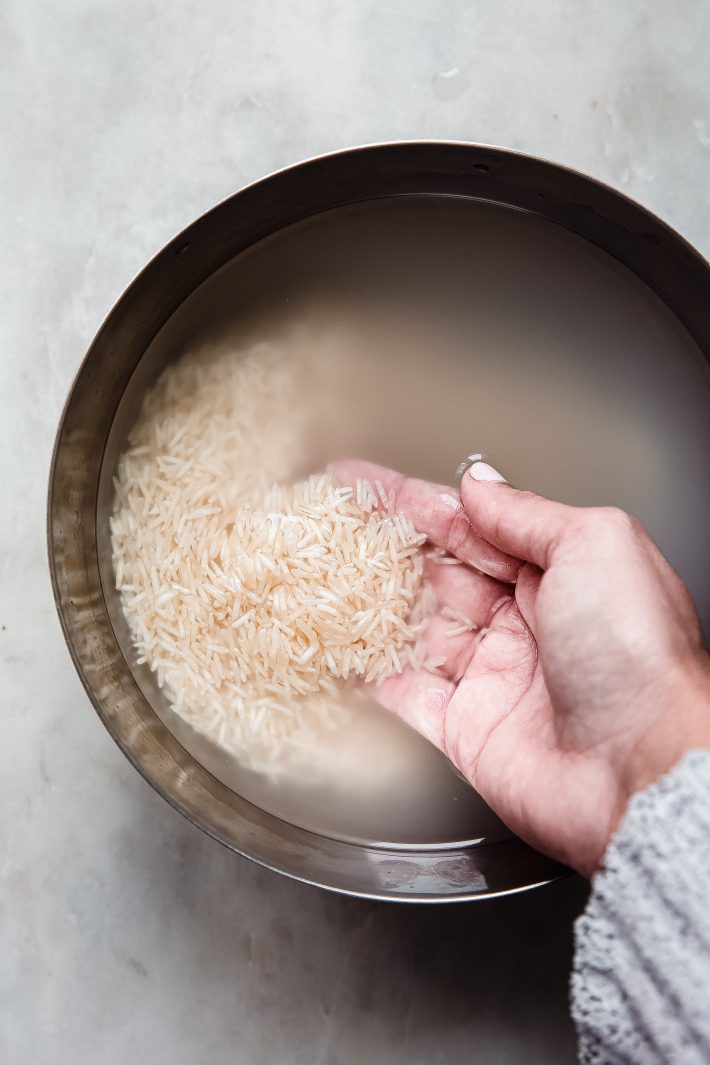
Why do you add vinegar when boiling the rice?
Adding a tablespoon of vinegar to the water when boiling basmati rice keeps the rice starches from sticking together. That way, you have fluffy rice that separates easily and doesn’t stick together.
How to make perfect basmati rice at home:
- Rinse and soak. The first step is to measure the rice, place it in a mesh strainer, and rinse it under cold running water for a few minutes until the water runs clear. This is usually done when making jasmine rice as well. This technique rinses out and cleans some of the starch that coats the grain of rice. Then, add the rice to a bowl and fill the bowl with cold water. Allow the rice to soak in cold water for at least 30-45 minutes. Soaking the rice reduces the amount of time required to boil the rice later. If you let the rice soak for an hour, you’ll want to decrease the boiling time by another minute or two. I don’t suggest going past the hour mark unless you use the specific brand suggested. Depending on the brand, sometimes the rice breaks into little pieces if you soak it for too long!
- Boil the rice. When the rice is about 15 minutes from completing the soaking time, add the water to a 3-quart saucepan (or larger) and bring it to a boil. When the water boils, reduce the heat to low for a second and add the salt and vinegar. Be careful! The water is going to start boiling rapidly at that point if you don’t lower the heat. Drain the rice in the sieve and add it to the boiling water. Allow the rice to cook until it’s just a hair underdone to your ideal preference. I start checking on the rice every minute once it crosses the 5-minute mark. Drain the rice in the same mesh strainer and rinse under cold running water. Rinsing the rice here removes any remaining starch that may be on the outer surface of the rice. Allow the rice to drain while you prepare the saucepan.
- Steam the rice. Make sure there’s no water remaining in the saucepan. Place the pan over medium heat, drizzle with oil and let it heat through. Add the rice back to the pot, cover with a tight-fitting lid and lower the heat setting to medium-low. Now listen for the rice to start sizzling. When it does, any remaining water has started creating steam, and you can turn the heat setting to low. Allow the rice to steam. Then turn off the heat and allow the rice to sit in the steam for about 5 minutes. This will finish cooking the rice all the way through and make it fluffy and perfect!
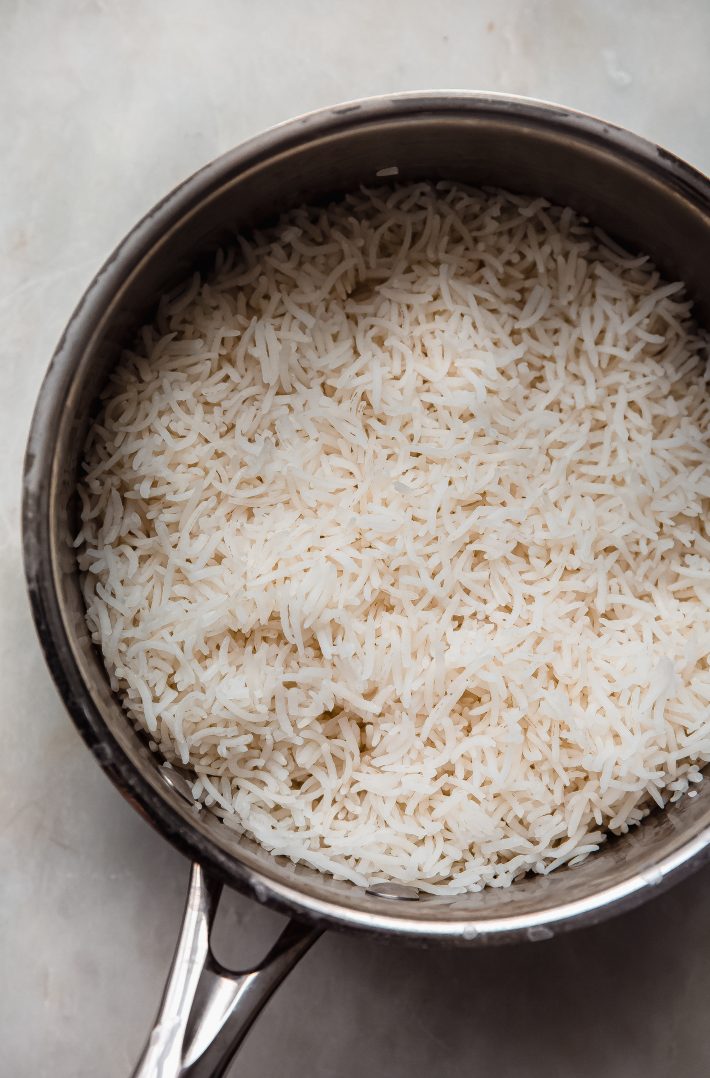
FAQs about making fluffy basmati rice:
- Do I have to double the water if I double the rice in this recipe? Nope, you don’t! The best thing about making Indian style basmati rice is that you don’t have to double the water each time, since it’s like boiling pasta. However, you do need to increase the water a little bit. For 1 cup of dry basmati rice, I use 8 cups of water. For 2 cups of rice, I use 10 cups of water. So for every additional cup of rice, you’ll add 2 cups of water.
- What about the salt and vinegar? The salt and vinegar will remain the same unless you triple the recipe. In that case, you’d up the salt to 3 tablespoons (for 12 cups of water.) The vinegar would also increase to 2 tablespoons at that point.
- Sometimes my Indian/Pakistani restaurant has whole cinnamon sticks, black peppercorns, and whole cloves in the rice. How would I make something like that? This is something that is done to give the rice a more fragrant aroma and flavor. You can easily do the same thing by adding a few whole spices to the rice when the water is boiling. I usually add 1 stick of cinnamon, 5-10 black peppercorns, 3-5 whole cloves, 1 star anise, 1 bay leaf, 3 green bay leaf, and ½ teaspoon cumin seeds. You can pick everything but the cumin seeds out before serving the rice if you’d like. It’s not fun when someone bites into a whole spice!
- Can I boil the rice in a dutch oven? You can. There are a couple of things to keep in mind, though. Since a cast iron pan retains its heat a lot better, the rice will take less time to boil than what’s listed. Also, when steaming the rice, you’ll want to let it steam on the low setting (don’t let it “sizzle” on medium-low.) The cast-iron pot will retain the heat well enough for it to just cook on the lowest setting the entire time.
- Can you freeze prepared basmati rice? Yes, you can! You can place the rice in an airtight container and freeze it, or you can place it in a zip-top bag and freeze it flat. I do find that the rice does break a little when you freeze it. However, flavor-wise, it’s absolutely fine!
What to serve with homemade Indian rice:
- The BEST Butter Chicken
- Homemade Palak Paneer (Saag Paneer)
- Chicken Tikka Masala
- 30-Minute Spicy Shrimp Masala
- Comforting Red Lentil Soup (Dal Soup)
- 30-Minute Garlic Brown Lentil Dal
- Creamy Chipotle Butter Chicken Meatballs
- Weeknight Chana Masala Rice Bowls
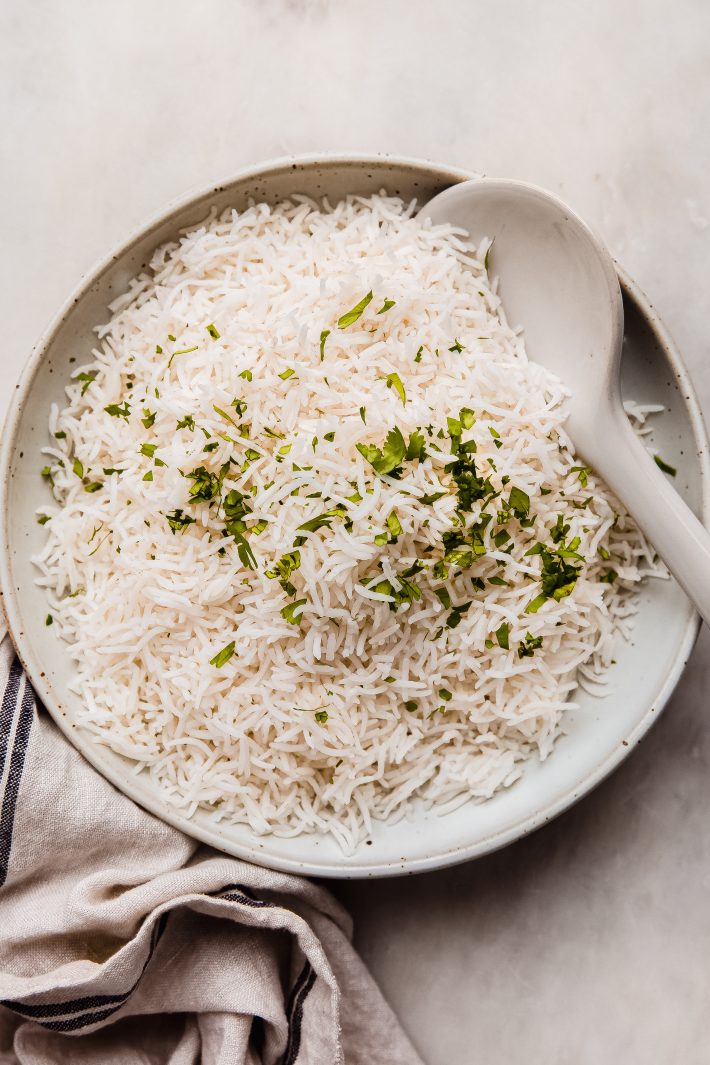
How to Make Perfect Basmati Rice
Learn how to make perfect basmati rice just like your favorite Indian restaurant! This fluffy, fragrant rice is easy to achieve at home with my method.

Ingredients
- 1 cup long-grain basmati rice
- 8 cups water
- 1 tablespoon kosher salt
- 1 tablespoon white vinegar
- 2 teaspoons oil
Instructions
- RINSE AND SOAK: Place the rice in a mesh sieve. Rinse under cold running water for at least 2-3 minutes. When the water runs clear, place the rice in a medium bowl and fill the bowl up with cold water. You want there to be at least 3 cups of water for 1 cup of rice. Allow the rice to soak for 30-45 minutes. During the last 15 minutes, bring the 8 cups of water to a boil in a 3-quart saucepan (or larger.)
- BOIL: When the water is boiling, lower the heat for just a second and add the salt and vinegar. Once the ingredients are added, kick the heat back up to medium-high. Drain the rice using a sieve. Add the rice to the boiling water and cook for 5-9 minutes. Check the rice every minute after the 5 minutes are up. You want it to be a hair underdone to your ideal preference. If you prefer softer rice, it’ll take you closer to 6-9 minutes. For a more al dente rice, aim for 4-6 minutes. Drain the rice in the same mesh sieve and do a quick rinse under cold running water. Let the rice drain while you prepare the saucepan.
- STEAM: Make sure there’s no water remaining in the saucepan. Place the pan over medium heat and drizzle with oil. Add drained rice to the pot, cover with a tight-fitting lid and lower the heat to medium-low. Listen to the rice to see when it just starts to gently sizzle. That’s when you can lower the heat to the lowest setting and continue to steam the rice for 6 minutes. Turn off the heat and allow the rice to sit for 5 minutes before plating and serving.





Will this same recipe work for brown basmati rice?
Hi Rick! Great question! This method would also work for brown basmati rice. However, I do suggest soaking the rice for longer (about 1 hour, if time permits) before boiling. Brown rice naturally takes longer to boil, but soaking it before boiling should cut the time it typically takes by about half. I’d start checking for doneness around 12 minutes; I haven’t tested it, but I would think it would take somewhere between 14-22 minutes. Hope that helps!
I want to make 2 cups of rice, do I need to double the amount of water?
Came out perfect! A little complicated to keep track of the first time around, but I think it will be easy now that I know the process. And I retyped it on my own recipe card in a format I’m used to. I used 1/2 tsp cumin seed. I didn’t have a sieve then — now I do 🙂 — so I laid cheesecloth in a colander. A little harder to deal with (took two people, 4 hands) but it worked. Sieve will be easier. Thanks for telling us how to make it like the Indian restaurant does!
I’ve been struggling to make fluffy basmati rice for a while and thought I’d try this recipe. Can only describe it in one word… Perfect! The rice came out fluffy and individual just as it would be if it came from an Indian restaurant!
So glad you were able to get that rice perfect, Charlie! Thank you for circling back to leave a review 🙂
Hi I was wondering if following this recipe, I’d lose the aroma of basmati rice. As use of vinegar plus rinses after it’s boiled. Do I not wash away all the aromas?
The joy of basmati it the comforting aroma
I love basmati rice and I doubted this recipe but it was perfect- better than any other times I have made it. Try it!
Wow this is my new favorite rice. I’ve made it twice in the past three nights.